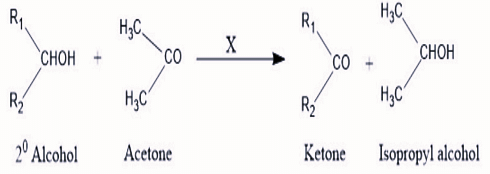Conversion of cyclic ketone to ring expended cyclic ester takes place by:
- Willgerodt rearrangement
- Baeyer Villiger rearrangement
- Michael rearrangement
- Lossen rearrangement
The Correct Option is B
Solution and Explanation
The given question involves the conversion of a cyclic ketone to a ring-expanded cyclic ester. This transformation is characteristic of the Baeyer-Villiger rearrangement.
Let's explore the Baeyer-Villiger rearrangement and understand why it is the correct choice here:
- Baeyer-Villiger Rearrangement: This is an organic reaction in which a ketone is oxidized by a peroxyacid, such as peracetic acid or m-chloroperoxybenzoic acid (m-CPBA), to form an ester or lactone. The mechanism involves the migration of the alkyl group adjacent to the carbonyl group through an oxocarbenium ion intermediate, expanding the ring when applicable.
In the case of cyclic ketones, the Baeyer-Villiger rearrangement results in ring expansion, converting the ketone into a cyclic ester (a lactone). This is why it correctly describes the provided transformation from a cyclic ketone to a ring-expanded cyclic ester.
Let's rule out the other options:
- Willgerodt Rearrangement: This reaction involves the conversion of aryl alkyl ketones into aryl alkyl amides or thiolamides, not into esters.
- Michael Rearrangement: This refers to a nucleophilic addition of a carbanion to an α,β-unsaturated carbonyl compound, which is not applicable here.
- Lossen Rearrangement: This rearrangement converts hydroxamic acids into isocyanates, which is unrelated to the conversion of ketones into esters.
Hence, the correct answer is the Baeyer-Villiger rearrangement, which efficiently converts cyclic ketones to ring-expanded cyclic esters.
Top Questions on carbonyl compounds
- Which of the following are neutral?
- KEAM - 2025
- Chemistry
- carbonyl compounds
- Acetone can be converted to 2-methylpropan-2-ol using:
- KEAM - 2025
- Chemistry
- carbonyl compounds
- The correct stability order of carbocations is
- JEE Main - 2024
- Chemistry
- carbonyl compounds
- According to Oppenauer Oxidation reaction, oxidation of secondary alcohol to ketone by reagent (X) in acetone takes place, what is "X" :

- GPAT - 2024
- Organic Chemistry
- carbonyl compounds
- The Gattermann-Koch reaction is used in the industrial preparation of benzaldehyde. The electrophile involved in this reaction is
- CUET (UG) - 2024
- Chemistry
- carbonyl compounds
Questions Asked in GPAT exam
- Which of the following alkaloids are found as salts of meconic acid?
- GPAT - 2025
- Introductory Pharmacognosy
Choose the correct match of laxative and its Mechanism of Action (MOA):

- GPAT - 2025
- Laxative
Match the following:
(P) Schedule H
(Q) Schedule G
(R) Schedule P
(S) Schedule F2
Descriptions:
(I) Life period of drugs
(II) Drugs used under RMP
(III) List of Prescription Drugs
(IV) Standards for surgical dressing
- GPAT - 2025
- Drug therapy
- Which of the following is used to evaluate disinfectant?
- GPAT - 2025
- Pathogens
Match the following:
(P) Tuberculosis (1) Bacterial
(Q) Diphtheria (2) Viral
(R) Yellow fever (3) Toxoids
(S) Malaria (4) Protozoal- GPAT - 2025
- Pathogens